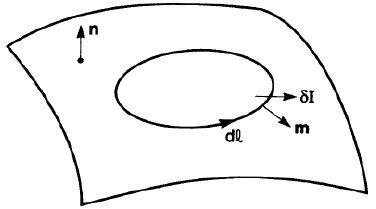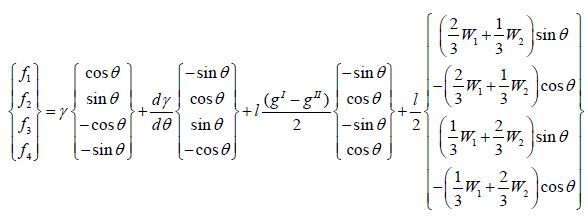

Theory

Atoms move only on the interface, so that the number of atoms added to the area equals the number of atoms flowing in across the contour. Thus
![]()
Mass conservation gives,
![]() and
and ![]()
The migration of the grain boundary is a degree of freedom independent of the relative motion of the two grains, and should be treated by the interface migration kinetics in the previous sections. Relative sliding of the two grains are often taken to be fast.
Define the driving force for diffusion, F, as the reduction of the free energy associated with atom moving unit distance on the interface. That is
![]()
Adopt a linear kinetic law:
![]() , M is mobility, influenced by temperature.
, M is mobility, influenced by temperature.
Mass conservation relates the velocity normal to the free surface to the flux divergence:
![]()
Associated with adding atoms on the interface, the free energy varies by
![]() .
.
Chemical potential on the surface
![]()
Diffusion driving force
![]()
A combined velocity normal to the surface to the flux divergence gives
![]()
Force acting on nodes by an element.
![]()
The force column includes physical effects. In this project an elastic energy W term is considered in the force. The ![]() term and
term and ![]() term are considered as zero, since this project mainly focuses on the interaction between voids. Thus the force column results in the following format.
term are considered as zero, since this project mainly focuses on the interaction between voids. Thus the force column results in the following format.


where,

![]() is the length of one element.
is the length of one element.![]() is the angle of the element to horizon.
is the angle of the element to horizon.
Thedivergence of ![]() appear in the same equation. Interpolate the mass displacement at points on the element by
appear in the same equation. Interpolate the mass displacement at points on the element by
![]()
with the interpolation coefficients being

Thus the flux at point s on the element is given by
![]()
In summary,

where [Hij] is a ![]() matrix
matrix

Here ![]() .
.

